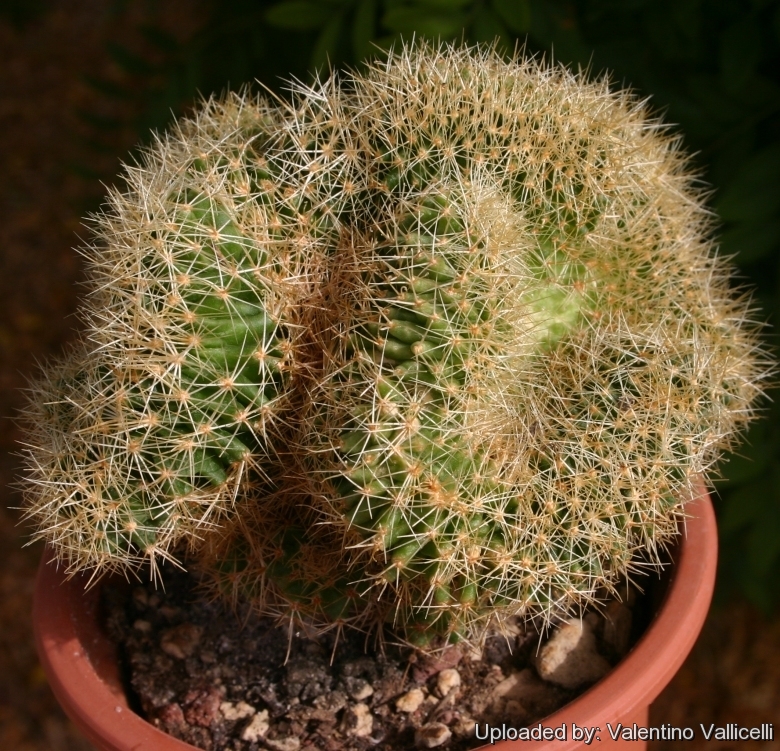= Thelocactus setispinus f. cristatus hort.
Accepted Scientific Name: Thelocactus setispinus (Engelm.) E.F.Anderson
Bradleya 5: 59. 1987

Hamatocactus setispinus f. cristatum (Thelocactus setispinus f. cristatus) Photo by: Valentino Vallicelli
Origin and Habitat: Garden origin (Nursery produced cultivar). The wild form grows in southern Texas and northern Mexico into Coahuila, Nuevo León and Tamaulipas.
Synonyms:
See all synonyms of Thelocactus setispinus
back
Accepted name in llifle Database:Thelocactus setispinus (Engelm.) E.F.AndersonBradleya 5: 59. 1987Synonymy: 34
Cultivars
(1):
back
Description: Thelocactus setispinusSN|3447]]SN|3447]], best known as Hamatocactus setispinusSN|3446]]SN|3446]] is a well known cactus species that produce a succession of large silky flowers in summer and autumn. The stem sizes vary from one population to another and the extreme forms are certainly very different. The crested form Thelocactus setispinusSN|3447]]SN|3447]] f. cristatus is very rare and sought after by collectors, for its unique features.
Roots: Long fibrous roots.
Stem: Fan shaped, 5-9 cm thik, yellow-green to dull blue-green.
Ribs: Thin, high, undulate on the margin, not tuberculate 1-2 mm wide, 14-18 mm high.
Areoles: 5-9 mm long, 2-3 mm wide, 20 mm apart, with extrafloral nectaries.
Radial spines: 9 to 17, slender, often 4 cm long, some white, others brownish, radiating, straight, 9-24 mm long.
Central spines: 1 to 3, longer than radials of which one, yellowish white to red, erect, hooked, 16-27 mm long.
Flower: Radial, 4-5(-7) cm long, 3-4cm in diameter, yellow, with a deep red centrer. Pericarpels scaly. Tube will developed. Inner perianth-segments oblong, acute, widely spreading. Stygma lobes pale yellow to white.
Blooming season: Summer to Autumn (Fall).
Fruit: Round, to ovoid, red with white pulp, 8-15 mm long, 10-14 mm in diameter, scaly, nearly naked, fleshy at maturity, indehiscent.
Seeds: 1,2 to 1,7 mm long, 0,5-0,8 mm in diameter, finely tuberculate.
Bibliography: Major references and further lectures
1) Edward Anderson “The Cactus family” Timber Press, Incorporated, 2001
2) James Cullen, Sabina G. Knees, H. Suzanne Cubey "The European Garden Flora Flowering Plants: A Manual for the Identification of Plants Cultivated in Europe, Both Out-of-Doors and Under Glass" Cambridge University Press, 11/Aug/2011
12) David R Hunt; Nigel P Taylor; Graham Charles; International Cactaceae Systematics Group. "The New Cactus Lexicon" dh books, 2006
13) Brian Loflin, Shirley Loflin “Texas Cacti: A Field Guide” Texas A&M University Press, 26/ott/2009
14) Albert Michael Powell, James F. Weedin “Cacti of the Trans-Pecos and Adjacent Areas” Texas Tech University Press, 2004
15) Del Weniger “Cacti of the Southwest: Texas, New Mexico, Oklahoma, Arkansas, and Louisiana” University of Texas Press, 1969
16) “Rare Plants of Texas: A Field Guide” Texas A&M University Press, 2007
17) Nathaniel Lord Britton, Joseph Nelson Rose “Cactaceae: Descriptions and Illustrations of Plants of the Cactus Family” Volume 3, 1922
18) Christopher Brickell “RHS Encyclopedia of Plants and Flowers” Dorling Kindersley Ltd, 01/set/2010
19) Campbell Loughmiller “Texas Wildflowers” University of Texas Press, 2006
20) Urs Eggli, Leonard E. Newton: “Etymological Dictionary of Succulent Plant Names.” Birkhäuser 2004
21) Pierre C. Fischer “70 Common Cacti of the Southwest” Western National Parks Association, 1989
22) Alfred Richardson “Plants of Deep South Texas: A Field Guide to the Woody and Flowering Species” Texas A&M University Press, 2010
23) Hiroshi Hirao “Colour encyclopaedia of cacti” Japan 1979 (Japanese language and script)
24) Willy Cullmann, Erich Götz (Dozent Dr.), Gerhard Gröner “The encyclopedia of cacti” Portland, OR: Timber Press, 1986
25) Hans Hecht “BLV-Handbuch der Kakteen” BLV-Verlagsgesellschaft, 1982
26) E Haustein “Der Kosmos Kakteenfuehrer (the Kosmos Cactus Guide)” Balogh Scientific Books 01 December 1998
27) Alwin Berger: “Kakteen: Anleitung zur Kultur und Kenntnis der wichtigsten eingeführten Arten.” Eugen Ulmer, Stuttgart 1929
28) Ulises Guzmán, Salvador Arias, Patricia Dávila: “Catálogo de cactáceas mexicanas.” Universidad Nacional Autónoma de México, Mexiko-Stadt 2003
29) Karl Schumann: “Gesamtbeschreibung der Kakteen (Monographia cactacearum).” J. Neumann, Neudamm 1899
30) George Engelmann, Asa Gray: “Plantae Lindheimerianae : an enumeration of F. Lindheimer's collection of Texan plants, with remarks and descriptions of new species, etc.“ 1845
Cultivation and Propagation: Although regarded as a choice and difficult plant is not too difficult in a greenhouse, although grows quite slowly. It is sometime seen as a grafted plant but grows very well on its own roots too.
Soil: Use mineral well permeable mineral soil with little organic matter (peat, humus).
Exposure: They need a good amount of light shade to full sun this help to keep the plants healthy, although slow growth.
Watering: Water sparingly from March till October (weekly during summertime, if the weather is sunny enough) , with a little fertilizer added. Less or no water during cold winter months, or when night temperatures remain below 10° to prevent root loss. It is sensitive to overwatering (rot prone).
Hardiness: Keep perfectly dry in winter at temperatures from 5 to 15 degrees centigrade. (but it is relatively cold resistant and hardy to -7° C, or less for short periods) In the rest period no high atmospheric humidity!! (Temperature Zone: USDA 9-11)
Propagation: Grafting or cuttings. Plants are usually grafted onto column-shaped cacti but proved to be able to produce their own roots if degrafted.










